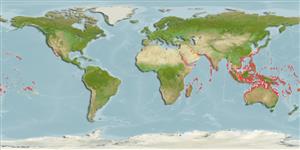>
Eupercaria/misc (Various families in series Eupercaria) >
Labridae (Wrasses) > Corinae
Etymology: Cheilio: Greek, chanos, -eos, ous, and chasma, -atos = abyss, mouth opened, inmensity + Latin, muraena = morey eel (Ref. 45335).
More on author: Forsskål.
Environment: milieu / climate zone / depth range / distribution range
ນິເວດວິທະຍາ
ສັດທະເລ ກ່ຽວກັນຫີນ; ລະດັບຄວາມເລິກ 1 - 30 m (Ref. 1602), usually 2 - 30 m (Ref. 27115). Tropical; 24°C - 27°C (Ref. 27115); 32°N - 36°S, 24°E - 109°W
Indo-Pacific: Red Sea and East Africa to the Hawaiian and Easter islands, north to southern Japan, south to Lord Howe Island.
ຂະໜາດ / ນ້ຳໜັກ / Age
Maturity: Lm ? range ? - ? cm
Max length : 50.0 cm SL ຕົວຜູ້/ບໍ່ມີເພດ; (Ref. 9823); common length : 35.0 cm TL ຕົວຜູ້/ບໍ່ມີເພດ; (Ref. 5450)
ຄີ (ໜາມ)ແຂງຢູ່ຫຼັງປາ (ທັງໝົດ): 9; ຄີຫຼັງຂອງປາ (ຄີອ່ອນ) (ທັງໝົດ): 12-13; ຄີ(ໜາມ) ແຂງຢູ່ຄີກົ້ນປາ
ກຸ່ມປາກະດູກແຂງ
ຄວາມຖີ່ຂອງກຸ່ມຖ່າຍທອດພັນ
ປາທີ່ມີການເຄື່ອນຍ້າຍຈາກທະເລໄປຫານ້ຳຈືດ ແລະນ້ຳຈືດຫາທະເລ
ປາທີ່ມີການເຄື່ອນຍ້າຍຈາກທະເລແລະໄປໄຂ່ຢູ່ນ້ຳຈືດ
ຄີກົ້ນຂອງປາ
ສັດທີ່ມີກະດູກສັນຫັຼງ
ການຖ່າຍທອດທາງກຳມະພັນຈາກພໍ່ແມ່ຫາລູກ 3; ຄີກົ້ນຂອງປາ: 11 - 12. Young individuals are usually a mottled brown or green, sometimes with a broad lateral stripe (Ref. 1602). Rare individuals may be uniformly yellow (Ref. 1602). Coloration in this fish is variable: green, brown, orange-brown or yellow, often with narrow, midlateral, broken black stripe which are absent in large males (Ref. 86689). Large males may develop a bright yellow, orange, black, white, or multicolored patch on their sides behind their pectoral fins (Ref. 1602).
Inhabit seagrass beds and algal-covered flats, occasionally in lagoon and seaward reefs to a depth of at least 30 m (Ref. 1602, 41878, 48636). Benthopelagic (Ref. 58302). Usually solitary. Juveniles secretive in seagrasses or attached Sargassum; adults usually in small loose aggregations, but occasionally form large schools to spawn (Ref. 48636). Feed mainly on crustaceans, mollusks, sea urchins (Ref. 37816) and other hard-shelled prey. Oviparous, distinct pairing during breeding (Ref. 205).
Life cycle and mating behavior
ການຈະເລີນເຕັມໄວ | ການສືບພັນ | ການວາງໄຂ່ | ໄຂ່ | ຄວາມດົກຂອງໄຂ່ປາ | ຕົວອ່ອນ
Oviparous, distinct pairing during breeding (Ref. 205).
Randall, J.E., G.R. Allen and R.C. Steene, 1990. Fishes of the Great Barrier Reef and Coral Sea. University of Hawaii Press, Honolulu, Hawaii. 506 p. (Ref. 2334)
IUCN Red List Status (Ref. 130435)
Threat to humans
Reports of ciguatera poisoning (Ref. 130160)
Human uses
ການປະມົງ: ທີ່ເປັນການຄ້າໜ້ອຍ; ຕູ້ປາ: ເປັນສີນຄ້າ
ຂໍ້ມູນຕື່ມອີກ
ຊື່ສາມັນຄຳສັບຄ້າຍຄືກັນການເຜົາໃໝ້ພະລັງງານໂດຍປ່ຽນທາດອາຫານໃນຮ່າງກາຍໃຫ້ກາຍເປັນຊີ້ນແລະໜັງຜູ້ລ້າການສຶກສາຜົນກະທົບຂອງສານຜິດທີ່ມີຜົນກະທົບຕໍ່ລະບົບນິເວດການສືບພັນການຈະເລີນເຕັມໄວການວາງໄຂ່ການສັງລວມການວາງໄຂ່ຄວາມດົກຂອງໄຂ່ປາໄຂ່Egg development
ເອກະສານອ້າງອີງການລ້ຽງສັດນ້ຳຂໍ້ມູນການລ້ຽງສັດນ້ຳສາຍພັນກຳມະພັນElectrophoresesການຖ່າຍທອດທາງກຳມະພັນຈາກພໍ່ແມ່ຫາລູກພະຍາດການປຸງແຕ່ງNutrientsMass conversion
ເຄື່ອງມື
Special reports
Download XML
ແຫຼ່ງອີນເຕີເນັດ
Estimates based on models
Preferred temperature (Ref.
123201): 24.4 - 29, mean 27.7 °C (based on 1206 cells).
Phylogenetic diversity index (Ref.
82804): PD
50 = 1.0000 [Uniqueness, from 0.5 = low to 2.0 = high].
Bayesian length-weight: a=0.00417 (0.00256 - 0.00679), b=3.09 (2.95 - 3.23), in cm total length, based on LWR estimates for this species & (Sub)family-body (Ref.
93245).
ຊັ້ນເຂດຮ້ອນ (Ref.
69278): 3.5 ±0.54 se; based on food items.
ຄວາມຢືດຢຸ່ນ (Ref.
120179): ຕຳ່, ປະຊາກອນຕຳ່ສຸດທີ່ໃຊ້ເວລາສອງເທົ່າ 4.5 - 14 ປີ (Preliminary K or Fecundity.).
Fishing Vulnerability (Ref.
59153): Moderate vulnerability (44 of 100).
Nutrients (Ref.
124155): Calcium = 43.3 [22.3, 72.7] mg/100g; Iron = 0.482 [0.278, 0.936] mg/100g; Protein = 18.1 [15.2, 20.3] %; Omega3 = 0.0782 [, ] g/100g; Selenium = 34.1 [18.2, 65.8] μg/100g; VitaminA = 92.6 [27.1, 350.8] μg/100g; Zinc = 1.33 [0.91, 2.07] mg/100g (wet weight);
